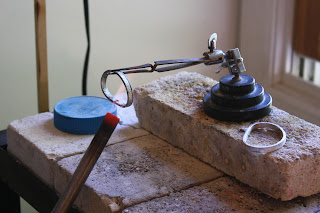Tuesday, October 12, 2010
Green is a Very Haute Color
I made some changes and I'm seeing green. And it is a very good thing indeed.
Lately, I have been doing a bit of research on how to make my studio more environmentally friendly. Partly because it is a fine thing to do for the planet but quite frankly, my main motivation is to make my workspace as safe as possible. It turns out that there are a lot of small changes I can make that can have a significant impact.
Silversmithing involves a number of chemicals and there isn't any way around that fact. Soldering requires that a chemical called flux be painted on the components to be joined. After each soldering application the piece needs to be bathed in a hot pickle bath which is typically hydrochloric acid. Finally, the finished piece is honed and polished on a motorized polisher with polishing compounds. It turns out that each of these steps can be done a little cleaner and safer with some substitutions.
I have switched to a non toxic chloride free flux from the UK which actually works even better at preventing firescale (a nasty discoloration that happens when silver is heated).
For the past few months I have been experimenting with different natural substitutions for hydrochloric acid. I have been using white vinegar that I boil down a bit to concentrate it. It works great but boy does it smell bad! Recently, I read an article from the American Society of Silversmiths and the author suggested the same thing that was used thousands of years ago...lemon juice concentrate. A perfect solution because a house that smells lemony is far more pleasant than one that reeks of vinegar!
Polishing is by far the dirtiest and most toxic thing about working in this medium. The typical polishing compounds contain silica which is a known carcinogen. There are some newer, less toxic alumina compounds that are silica free and I just ordered my first batch. It takes more time, but I have also been reducing the amount of polishing required by doing more sanding by hand. By the way, I do polish with the garage door wide open and I always wear a respirator.
The amount of silver scraps I generate boggles my mind. The box on my bench seems to always be full. I buy my sterling silver in rectangular sheets of varying gauges and most of my pieces of jewelry are round or oval so you can imagine how much waste there is. I can box up the scraps and send them to be melted down and remanufactured but I've been thinking that maybe I can find a way to use a lot of that material. I have started to take my larger scraps from making pendants and put them through my rolling mill (think industrial style pasta machine) to make thinner gauged pieces that are a perfect weight for making earrings. I have been melting down some small pieces myself too. In fact, I have a series of necklaces that I am working on that makes use of my small scraps. I think it's kinda clever and I'll write about it soon.
This whole process was surprisingly simple with no change to the quality of the finished pieces. So now I have been tossing around another lofty goal which would make things even greener...using only domestic materials. But let's not get carried away ...there are far too many pretty stones from all over the world.
Subscribe to:
Post Comments (Atom)

such an interesting post. i wasn't aware of how much work goes into making a piece. you are one talented silversmith my friend. i adore your work!
ReplyDelete